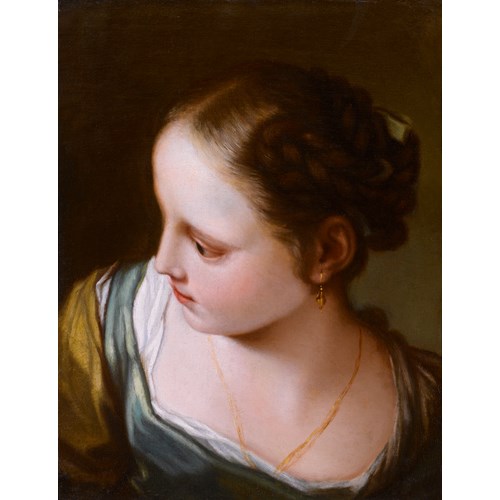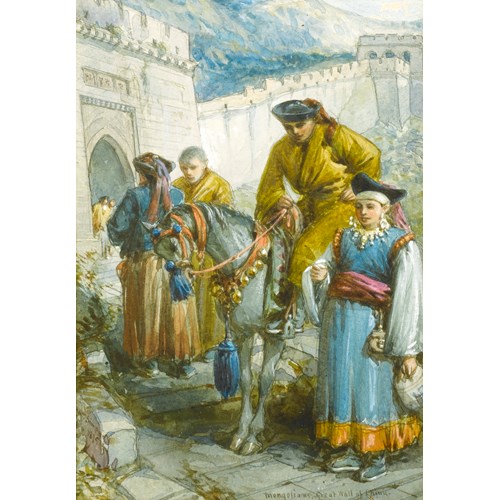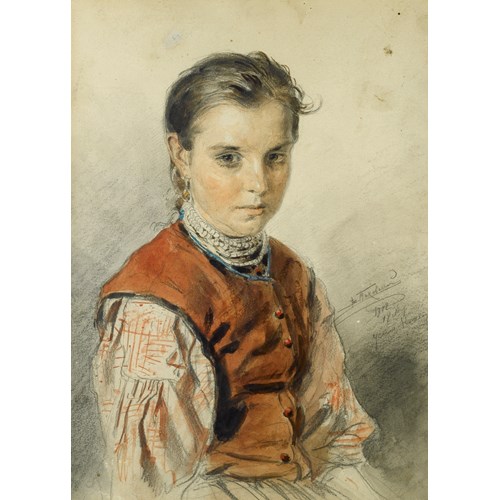Marketplace
Kalmyk Wedding
Baron Joseph Berres von Perez
Kalmyk Wedding
Period 1850-1900, 19th century, 20th century
Origin Austria
Medium Oil on canvas
Dimension 79.5 x 118 cm (31¹/₄ x 46¹/₂ inches)
Kalmyk Wedding is a lively painting of a group on horseback with the bride and groom in the centre, their heads covered in white head-dresses, both riding side by side. Baron Josef Berres von Perez creates the sense of a festive atmosphere, emphasised by the be-ribboned decoration that the rider at the far left of the group is holding, and by the musical triangle held by the rider wearing red trousers to the centre-left of the work. He has also created a real sense of movement with the bustling group riding at pace en masse. In the background are three yurts, traditional dwellings of the Kalmyks, and a large inlet of water.
The Kalmyk people originate from Asia, reaching Europe when Genghis Khan created his Mongol Empire. Kalmykia has existed as an independent nation since the fifteenth century, and is the only Buddhist Republic in Europe. The Kalmyk people originally migrated westward from Central Asia to the lower Volga area in the seventeenth century. They formed a frontier khanate, a territory ruled by a Mongol ruler, or Khan, who swore allegiance to Russia in return for protection against Tatar attack. The khanate became absorbed into the Russian province of Astrakhan in the eighteenth century. The Kalmyk Autonomous Oblast was established in 1920 and later raised to the status of an Autonomous Republic in 1935. Under Stalin’s harsh regime of agricultural collectivisation and enforced deportation, the Kalmyk people severely suffered during the 1930s and 1940s. However, in 1958 they were rehabilitated and since then their culture and Buddhist faith have undergone something of a revival. The province was declared an Independent Republic of the Russian Federation in 1991.
Von Perez was a professional soldier and through his long career he was actively involved in numerous military engagements. At the age of forty five von Perez resigned from his position as Major General of the Austrian Army to become a full-time artist. As part of his studies he travelled frequently to the Volga region and the Caucasus. His enduring interest in painting also led to friendships with several Orientalist painters, such as Bertalan Szekely and Mihaly Munkacsy. Between 1866 and 1869 he studied with Karl Theodor von Piloty at the Munich Academy. He travelled to Hungary on several occasions as well as undertaking an extensive journey to Russia, in particular to the Volga and Caucasus regions. In 1871 he became a member of the Vienna Künstlerhaus; the oldest artist association of Austria.
The Kalmyk people originate from Asia, reaching Europe when Genghis Khan created his Mongol Empire. Kalmykia has existed as an independent nation since the fifteenth century, and is the only Buddhist Republic in Europe. The Kalmyk people originally migrated westward from Central Asia to the lower Volga area in the seventeenth century. They formed a frontier khanate, a territory ruled by a Mongol ruler, or Khan, who swore allegiance to Russia in return for protection against Tatar attack. The khanate became absorbed into the Russian province of Astrakhan in the eighteenth century. The Kalmyk Autonomous Oblast was established in 1920 and later raised to the status of an Autonomous Republic in 1935. Under Stalin’s harsh regime of agricultural collectivisation and enforced deportation, the Kalmyk people severely suffered during the 1930s and 1940s. However, in 1958 they were rehabilitated and since then their culture and Buddhist faith have undergone something of a revival. The province was declared an Independent Republic of the Russian Federation in 1991.
Von Perez was a professional soldier and through his long career he was actively involved in numerous military engagements. At the age of forty five von Perez resigned from his position as Major General of the Austrian Army to become a full-time artist. As part of his studies he travelled frequently to the Volga region and the Caucasus. His enduring interest in painting also led to friendships with several Orientalist painters, such as Bertalan Szekely and Mihaly Munkacsy. Between 1866 and 1869 he studied with Karl Theodor von Piloty at the Munich Academy. He travelled to Hungary on several occasions as well as undertaking an extensive journey to Russia, in particular to the Volga and Caucasus regions. In 1871 he became a member of the Vienna Künstlerhaus; the oldest artist association of Austria.
Period: 1850-1900, 19th century, 20th century
Origin: Austria
Medium: Oil on canvas
Signature: Signed (lower left)
Dimension: 79.5 x 118 cm (31¹/₄ x 46¹/₂ inches)
Literature: A woodcut of this work has appeared in the periodical Gartenlaube, 1880, F. von Boetticher, Malerwerke des Neunzehnten Jahrhunderts, vol. 1, p. 92.
Exhibition: Probably exhibited at the Wiener Kuenstlerhaus in 1875 under the title Kalmyks in the South Russian Steppes
More artworks from the Gallery








, in a Green Dress and Pearls, Standing at a Draped _T638990626119457264.jpg?width=500&height=500&mode=pad&scale=both&qlt=90&format=jpg)
